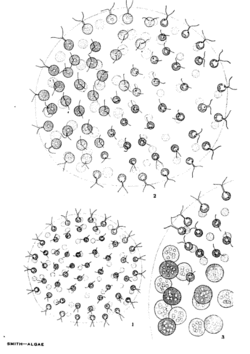Biology:Pleodorina
| Pleodorina | |
|---|---|

| |
| Pleodorina californica (GM Smith, 1920, plate 57, p 97.)[1] | |
| Scientific classification | |
| (unranked): | Viridiplantae |
| Division: | Chlorophyta |
| Class: | Chlorophyceae |
| Order: | Chlamydomonadales |
| Family: | Volvocaceae |
| Genus: | Pleodorina W.R.Shaw |
| Species | |
| |
Pleodorina is a genus of colonial green algae in the family Volvocaceae.[2] Description by Gilbert M. Smith (1920, pp 96–97).[1]
Pleodorina Shaw 1894:
Colonies always motile; spherical to sub-spherical, with 32-128 cells lying some distance from one another just within the periphery of the homogeneous, hyaline, gelatinous, colonial envelope and not connected by cytoplasmic strands. Cells differentiated into those that are purely vegetative in character and those capable of dividing to form daughter colonies. All but four cells of the colony reproductive or about half reproductive and half vegetative. Cells spherical to ovoid in shape. Vegetative cells with a cup-shaped chloroplast containing one pyrenoid; a large anterior eyespot; two cilia of equal length with two contractile vacuoles at their base. Reproductive cells at first like the vegetative cells, later with a more massive chloroplast that eventually contains several pyrenoids. The eyespot and cilia of reproductive cells disappearing when they are mature.
The young colonies of Pleodorina look very much like those of Eudorina (Smith, 1920, p 97.)[1]
References
- ↑ Jump up to: 1.0 1.1 1.2 Smith, GM. Phytoplankton of Inland Lakes of Wisconsin, Part I, Wisconsin Geological and Natural History Survey, Madison, WI. (1920).
- ↑ See the NCBI webpage on Pleodorina. Data extracted from the "NCBI taxonomy resources". National Center for Biotechnology Information. http://ftp.ncbi.nih.gov/pub/taxonomy/. Retrieved 2007-03-19.
Further reading
Scientific journals
- "Differences in pyrenoid morphology are correlated with differences in the rbcL genes of members of the Chloromonas lineage (Volvocales, Chlorophyceae)". J Mol Evol 55 (4): 414–430. 2002. doi:10.1007/s00239-002-2338-9. PMID 12355262.
External links
- Pleodorina - Description with pictures
Wikidata ☰ Q300542 entry
 |

